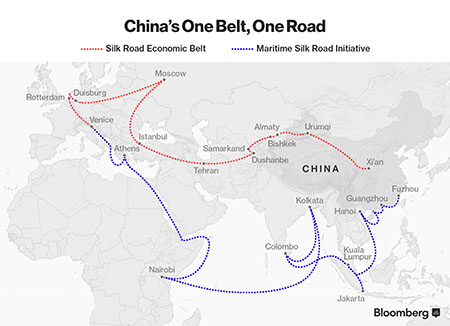
 The One Belt One Road initiative is China’s strategic economic and foreign policy to bolser regional connectivity by boosting cross-border trade and investments in 65 countries across Asia, the Middle East and Europe. The initiative will generate new growth momentum in infrastructure, service and trade networks through the land-based Silk Road Economic Belt and the ocean-based 21st Century Maritime Silk Route. Nearly 70 countries have expressed interest in participating in the OBOR action plan.
The One Belt One Road initiative is China’s strategic economic and foreign policy to bolser regional connectivity by boosting cross-border trade and investments in 65 countries across Asia, the Middle East and Europe. The initiative will generate new growth momentum in infrastructure, service and trade networks through the land-based Silk Road Economic Belt and the ocean-based 21st Century Maritime Silk Route. Nearly 70 countries have expressed interest in participating in the OBOR action plan.
What are the spin-offs for the MICE industry?
1. The OBOR will promote multilateral trading, free-trade zones, liberalisation at facilitation of trade and investment, leading to more people-to-people exchanges and creating more business events opportunities. As a result of improved connectivity and more relaxed visa regulations, Chinese corporate incentive buyers are now looking for new, affordable and exotic destinations for their clients. Cost and a match to business interests have now emerged as key factors in buyers’ choices of places to hold their events.
2. In Malaysia, riding on the OBOR momentum, the nation’s 4,000-plus Chinese clan associations are being invigorated by the investment opportunities under the Belt and Road. One example is the Federation of Hokkien Associations in Malaysia, the largest clan association in the country, which has set up a chamber of commerce in order to tap into potential business. Clan associations can be found in almost every overseas Chinese community and represent a social and business bond with China. Clan reunions can be large and rotate among destinations, like association congresses. Clan members attend such gatherings to find their roots, connect with other members, for social purposes and to develop business connections.
3. China is starting to explore various international convention and exhibition markets – 128 exhibitions were held abroad in 2016, a trend that will intensify the future years with further implementation of OBOR.
4. The strategic objectives of Belt and Road are closely connected to the “going out” strategy of many Chinese corporations and businesses. This means they will have a global outlook in terms of where their events can be held. Chinese trade associations are also expected to generate more events as a result of greater autonomy granted to them by the government. This will encourage them to meet outside the country in search of new investment opportunities. This sea change will mean growth in China’s association congresses leading to evolutionary charge in the global meetings industry.

Jane Vong Holmes is senior manager, Asia, with Gaining Edge. This is an edited version of an article produced by GainingInsights


